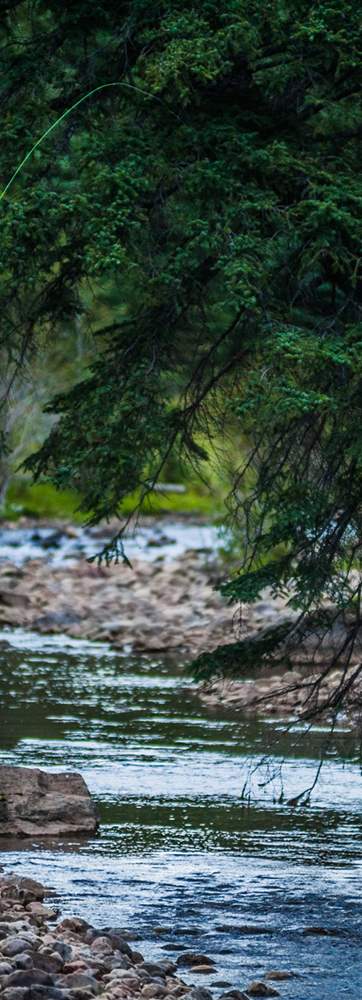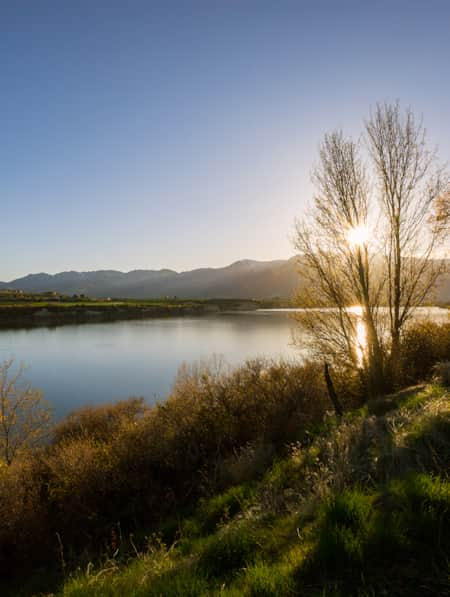- Home
- Things To Do
- Fishing
- Fishing Duchesne River

Fishing Duchesne River
- Weather: Mostly Clear, 26F
The Duchesne River, a tributary of the Green River (Watch: The Green Less Traveled), drains the southwest slope of the Uinta Mountains, and has become a popular choice for local fisherman. The main river, the West Fork, and the North Fork combine for more than 80 miles of diverse fishing. There are limited access points to the rivers, and some require a bit of a hike, but the locals will tell you that it’s worth it.
The Duchesne’s origins on the south slope of the Uinta Mountains make it a popular destination for camping, hiking and ATV riding, so it’s only natural to bring along a rod for some fishing, too. Fishing is good here year round, but the best time to come is July through September. The area is driving distance to the community of Hanna or the town of Duchesne for supplies or amenities.
Upper Portion, West Fork
The upper portion of the West Fork of the Duchesne River runs through the Ashley National Forest, and has a variety of wildlife and towering pine, spruce and fir trees. Further down, native cottonwood and willows grow along the river banks. The West Fork is home to an abundance of native Colorado River cutthroat trout and is also known for a population of wild brown trout. Look along the banks for terrestrial insects such as cicadas, ants and grasshoppers for clues as to which is the best to use.
Note that the majority of the Duchesne drainage is open to all kinds of fishing, but the West Fork regulations permit only artificial flies and lures. Spincast, spinning, baitcast or fly tackle are used here, which makes West Fork a great place for novice and more experienced anglers.
Lower Portion, North Fork
The lower section, Hanna to North Fork, runs from the town of Hanna up to the confluence of the West and North Forks of the Duchesne River, just off Highway 35. This area is more wide open, and is a great place to catch naturally reproducing mountain whitefish, as well as cutthroat, brown and rainbow trout. Like the West Fork, Hanna to North Fork is also popular with both novice and experienced anglers, and the best bait includes grasshoppers, crickets, salmon eggs, night crawlers, waxworms or mealworms. Live crayfish can be used as bait in areas where the crayfish is captured, and using live baitfish and tiger salamanders is prohibited.
Regulations
The West Fork is approximately 14 miles northwest of the town of Hanna on State Road 35. Access on the West can be tricky due to private property, but the state has worked with landowners to grant access to the lower West Fork, while the upper stretches are accessed via U.S. National Forest Service lands.
The lower portions of the creek run along State Road 35, also known and the Wolf Creek Road. Only access the river from designated parking areas along Highway 35 and at the Sand Creek Bridge — do not cross private property.
Planning Resources
- Buy a Utah fishing license
- Fishing regulations in Utah
Learn more about fishing in Utah
Discover More
-

A Local’s Guide to Logan: Northern Utah’s Outdoor Adventure College Town
Written By Arianna Rees
3 minute read
Logan is teeming with some of the best arts, food and outdoor adventure opportunities in the state. Whether you’re passing through or just looking for new places to explore, here are some of the best ways to experience Logan.
-

Alpine Fishing Above the Red Rock Landscapes of Southern Utah
Written By Visit Utah
2 minute read
Sitting just outside of Capitol Reef National Park, this 11,000-foot peak offers views of the surrounding red canyons and desert-like region. In contrast, Boulder Mountain is heavily forested and home to more than 80 lakes, ponds, and reservoirs. With an average rainfall multiple inches more than the lower regions, the area makes for some surprisingly good fishing.
-

An Old Favorite Fishing Hole at the Flaming Gorge Reservoir
Written By Dan Potts
6 minute read
Visit Utah columnist Dan Potts takes us to his "secret" fishing hole on Utah's Flaming Gorge Reservoir, one of the world's most diverse fisheries set among the brilliant red rock walls of Red Canyon in the easternmost corner of the state. Along the way, Dan takes us through some of his favorite landscapes on the drive to and from Salt Lake City.
-

Angling Secrets: How and Where to Catch Fish on Lake Powell
Written By Visit Utah
3 minute read
Read expect advice on when and where in Lake Powell to get the prized fish you're chasing.
-

Bear Lake Monster Winterfest
Written By Ben Whisenant
8 minute read
It all started decades ago with the “Cisco Disco” and has grown to include a polar plunge, chili cookoff and winter festival known as the Bear Lake Monster Winterfest.
-

Discovering the Quiet Beauty of Hyrum Lake State Park
Written By Matcha
4 minute read
Spend some time at Hyrum Reservoir and you’ll discover that crisp clear water and a spot on the grass are all you really need for a relaxing getaway. Throw in pristine mountain views and a shady spot to set up camp and consider your summer vacation plans as good as done.
-

Enjoying the Simple Pleasures of Lake Life on Palisade Reservoir
Written By Visit Utah
4 minute read
Utah’s beautiful Palisade Reservoir is an oasis of serene water in the central part of the state, a perfect getaway for paddling, fishing, swimming and camping.
-

Find a Winter Refresh in a Utah State Park
Written By Rosie Serago
4 minute read
The best Utah state parks will entice you with ice fishing, white sand and snow-dusted scenery. Take a winter break to refresh with a visit to a few of these places.
-

Finding Solitude on the Provo River
Written By Matcha
Get expert advice on Provo River fishing, recreation and relaxation. Add the Provo River to your next Utah itinerary!
-

Fishing Fish Lake
Written By Matcha
5 minute read
The largest natural mountain lake in Utah, Fish Lake sits at more than 8,800 feet of elevation, which makes for pleasant weather all summer long. Located near Richfield, Utah, the lake has everything you need for a relaxing summer getaway.
-

Fishing Northern Utah's Logan River
Written By Matcha
Why do serious fly fishers flock to Northern Utah’s Logan River? Fishing spots with rainbow and brown trout in our freestone dream streams. Plan your adventure!
-

Fly Fishing the Uinta Mountains
Written By Matcha
The Uinta Mountains are one of Utah’s top fly fishing destinations. Learn where to go and how to land that trophy trout, then plan your own fly fishing getaway.
-

Get to Know Echo State Park
Written By Matcha
4 minute read
Situated at 5,560 feet above sea level, just north of Park City, lies Echo State Park. Watersports are king here, and whether you kayak, paddleboard, or boat, it’s a perfect place to get out on the water.
-

How to Have the Perfect Weekend on the Water at Quail Creek State Park
Written By Matcha
4 minute read
Just 15 miles north of St. George and even closer to the town of Hurricane, Quail Creek State Park offers warm water and mild weather year round. There’s plenty to do out on the water, and the gorgeous setting is sure to impress.
-

In Search of the Yellowstone Cutthroat
Written By Sandra Salvas
7 minute read
Fishing for what counts in Utah’s remote Raft River Mountains.
-

Panguitch Lake's Literal "Big Fish"
Written By Matcha
People have been traveling to fish at Panguitch Lake for a long time. Legend has it this popular high mountain fishery in Southern Utah was named by the Paiute people who once frequented the area and it translates to mean “big fish.”
-

Ramble On: An Insider's Guide to Beaver County
Written By VistaWorks
5 minute read
Ramblers, also known as Beaver County, is an outdoor playground. From winter to summer, check out the top 10 things to see and do in Ramblers.
-

Riding the Arapeen OHV Trail of Central Utah
Written By Ben Whisenant
6 minute read
Looking for the best off-roading trails in Utah? You have to try the Arapeen OHV Trail, featuring hundreds of miles of scenic backcountry trails in Central Utah. Start planning now!
-

Strawberry Reservoir: Ripe for All Kinds of Anglers
Written By Matcha
With trophy-sized cutthroats and rainbows, large populations of aquatic insects and ample wade fishing opportunities, Strawberry Reservoir — affectionately called "the Berry" — really does have something for every angler’s tastes.
-

The Most Scenic Trophy Trout Destination
Written By Matcha
Flaming Gorge, Utah is one of the world’s best places to fish for trout. Awe-inspiring scenery and abundant fish attract anglers from all over. Check it out!
-

The Story of Starvation Reservoir
Written By Matcha
Sprawling waters and local legends at Fred Hayes State Park at Starvation.
-

The Story of Utah Women Flyfishers
Written By Brett Prettyman
4 minute read
Get to know Heidi Lewis, founder of Utah Women Flyfishers. More than 300 women meet monthly to tie flies, practice casting at the park, plan trips and more.
-

The Wayward Path of a Utah Fly-Fishing Guide Led Straight to the Green River
Written By Brett Prettyman
5 minute read
Colby Crossland isn’t quite sure how he ended up a guide on one of the country’s best fly-fishing destinations, but he knows the perks are worth the tangles.
-

Where To Fish in Utah This Spring
3 minute read
We've got your Northern and Southern Utah recommendations for where to fish this spring.
-

Wild Heber: Close-to-Home Adventure
Written By Kristen Pope
8 minute read
Just 45 minutes from Salt Lake City, Heber Valley’s state parks and national forest lands offer a world of adventure. Hike, bike, camp, kayak, watch wildlife and reel in blue-ribbon trout while learning about nature and how to protect it.

























